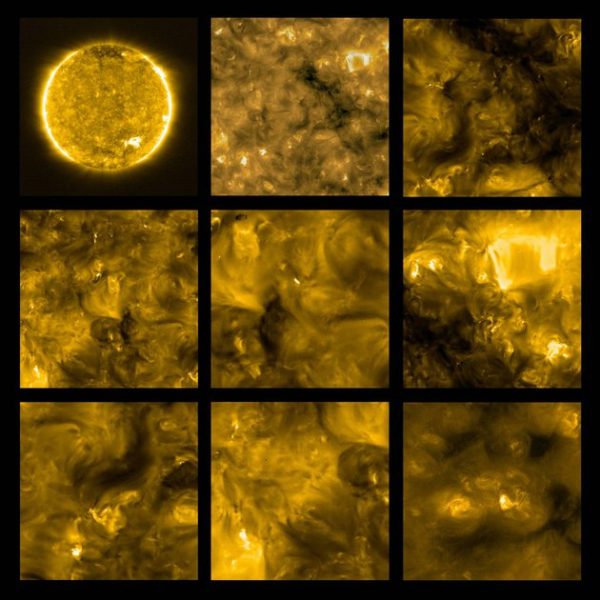NASA показало, как выглядит Солнце с рекордно близкого расстояния (ФОТО, ВИДЕО)

Национальное управление по аэронавтике и исследованию космического
пространства (NASA) обнародовало новые фотографии Солнца, сделанные с
расстояния всего в 77 млн км.
Об этом пишет The Verge.
Изображения были сделаны зондом в рамках проекта Solar Orbiter.
“На самом деле мы не ожидали, что первые снимки получатся
настолько великолепными. Они не только очень детальные и отлично раскрыты с
технической точки зрения, но и также показывают вещи, которые мы не видели
раньше”, – отметил исследователь проекта ESA для миссии Solar Orbiter Даниэль
Мюллер.
На фотографиях можно увидеть миниатюрные вспышки. Ученые, назвали эти маленькие вспышки “кострами”, они в миллионы раз меньше вспышек на Солнце, которые можно увидеть с Земли с помощью телескопов. Десятки этих “костров” можно увидеть в любой момент в поле зрения камеры солнечного орбитального аппарата.
Посмотреть эту публикацию в Instagram Prepare your shades, we are taking you close to the Sun 😎 ⠀⠀⠀⠀⠀ The first images from Solar Orbiter, our new Sun-observing mission together with NASA, have revealed omnipresent miniature solar flares, dubbed ‘campfires’, near the surface of our closest star. ⠀⠀⠀⠀⠀ The campfires shown in the first image set were captured by the Extreme Ultraviolet Imager from Solar Orbiter’s first perihelion, the point in its elliptical orbit closest to the Sun. At that time, the spacecraft was only 77 million km away from the Sun, about half the distance between Earth and the star. ⠀⠀⠀⠀⠀ The scientists do not know yet whether the campfires are just tiny versions of big flares, or whether they are driven by different mechanisms. There are, however, already theories that these miniature flares could be contributing to one of the most mysterious phenomena on the Sun, the coronal heating. ⠀⠀⠀⠀⠀ The solar corona is the outermost layer of the Sun’s atmosphere that extends millions of kilometres into outer space. Its temperature is more than a million degrees Celsius, which is orders of magnitude hotter than the surface of the Sun, a ‘cool’ 5500 °C. After many decades of studies, the physical mechanisms that heat the corona are still not fully understood, but identifying them is considered the ‘holy grail’ of solar physics. ⠀⠀⠀⠀⠀ The Polarimetric and Helioseismic Imager is another cutting-edge instrument aboard Solar Orbiter. It makes high-resolution measurements of the magnetic field lines on the surface of the Sun. It is designed to monitor active regions on the Sun, areas with especially strong magnetic fields, which can give birth to solar flares. During solar flares, the Sun releases bursts of energetic particles that enhance the solar wind that constantly emanates from the star into the surrounding space. ⠀⠀⠀⠀⠀ Go to esa.int to learn more about these images. ⠀⠀⠀⠀⠀ 📸1️⃣2️⃣3️⃣Solar Orbiter/EUI Team (@europeanspaceagency & @nasa); CSL, IAS, MPS, PMOD/WRC, ROB, UCL/MSSL 📸4️⃣5️⃣6️⃣7️⃣ Solar Orbiter/PHI Team/ESA & NASA 📸8️⃣9️⃣Solar Orbiter/Metis Team (ESA & NASA) 📸🔟 Solar Orbiter/SoloHI Team (ESA & NASA); U.S. Naval Research Laboratory Публикация от ESA (@europeanspaceagency) 16 Июл 2020 в 8:55 PDT
Однако непонятно, что именно вызывает эти мини-вспышки.
Типичные солнечные вспышки часто происходят, когда Солнце считается активным –
когда темные пятна появляются на поверхности звезды, заставляя части магнитного
поля Солнца вращаться и поворачиваться. Но мини-вспышки не появляются во время
интенсивной активности на Солнце.
Solar Orbiter был запущен в феврале для исследования Солнца и его гелиосферы, а также процессов, которые отвечают за создание солнечного ветра. Предполагается, что за два года аппарат приблизится к звезде и позволит увидеть ее с 42 миллионов километров.
создал по заказу NASA запах космоса
Comments